How to Draw Antlers Step by Step

In this tutorial, we’ll draw a pair of antlers—a beautiful element from the world of nature. We’ll start with a graphite pencil sketch, designing the typical structure of deer antlers from scratch. Then we’ll create an illusion of texture and complete our drawing using ink liners.
But first, let’s talk about the difference between horns and antlers. It’s always useful to learn more about the object you’re going to draw!
Antlers are grown as an extension of the animal's skull and are a single structure. They are generally found only on males of the Cervidae family, which includes all species of deer, moose, and elk. Antlers are grown every spring and shed every winter.
Horns, on the other hand, are two-part structures. They are found on members of the Bovidae family, which includes species as diverse as cows, sheep, goats, and even antelopes and gazelles. Both males and females may have horns, and the size and shape of horns vary from species to species.
With rare exceptions, horns are never branched and never shed. In many species, horns never stop growing throughout an animal's life.
What You Will Need
To complete this project, you'll need the following equipment:
- a graphite pencil (I recommend using an HB or B type)
- an eraser
- an ink liner number 0.05
- an ink liner number 0.1
- an ink liner number 0.2
- a sheet of drawing paper

1.How to Draw Antlers With a Graphite Pencil
Step 1
I outline the border of the skull, just for our reference, and then add a core line.

Each antler grows from an attachment point on the skull called a pedicle. I mark the foundations of the antlers, using oval shapes.

Step 2
I draw the framework of the horns. We’ll start with simple forked structures and add more elements later.
Antlers often have a slight asymmetry and non-typical tines, so don’t strive for absolute perfection.
I also recommend drawing both antlers simultaneously, because if you draw just one and then copy and flip it digitally, your artwork won’t look natural.

Step 3
I draw the contours of the longest parts of the antlers, also known as the main beams or antler stems.

Step 4
I draw the short transitional parts; they join the branches with the antler stems.
As you can see in the image, I add the oval shapes to these parts, as if we’re looking at the antlers in a cross-section. Thinking about the formsin this manner helps to make the drawing more realistic.

I draw the branch growing from the main beam.

Step 5
I add two shorter branches to the antler stems; let's agree that they are not equal.

Step 6
I draw the curved branches that are facing the viewer.

To emphasize the direction of these branches, I add a border between their sides. Now the front branches look more credible.

Step 7
I draw the short branches in the lower part of the antlers. Another name for these elements is the brow tines.

Step 8
I refine the contours of the antlers, making the lines smoother. Now you can add some new tines or creative features if you wish.
It’s time to erase the unnecessary pencil lines.

Step 9
Let’s add some texture to the base part of the antlers (it is called a burr, or coronet). The coronet has a distinctive pattern, resembling a set of outgrowths.

Step 10
I draw long graphite lines, marking the texture of the main beam and the branches. The texture here is much smoother than on the coronet part.

2.How to Draw Antlers With Ink Liners
Step 1
I outline the main contours of the antlers, using the 0.2 ink liner.

Step 2
With the 0.1 ink liner, I add the lines to create a texture. You can find a sample of this hatching in the image below.

Step 3
I add some shadows to the texture, applying groups of short horizontal hatches. Our goal here is to reveal the contours of the texture.

Step 4
With the 0.05 liner, I add contour hatching to the sides of the main beam and branches. The drawing looks more three-dimensional!

Step 5
With the 0.1 liner, I increase the contrast in my drawing, adding more short hatches and dots to the core shadows.

Your Drawing Is Complete
Congratulations! You’ve created a beautiful artwork; I hope you enjoyed both the process and the result.
I wish you much success in drawing with graphite pencils and ink. Have fun capturing the unique charm of the wonderful world of animals and nature!

Original Link:
TutsPlus - Design
 TutsPlus+ is a blog/Photoshop site made to house and showcase some of the best Photoshop tutorials around.
TutsPlus+ is a blog/Photoshop site made to house and showcase some of the best Photoshop tutorials around.More About this Source Visit TutsPlus - Design

